Udon Vs Soba: What Truly Sets The 2 Noodles Apart
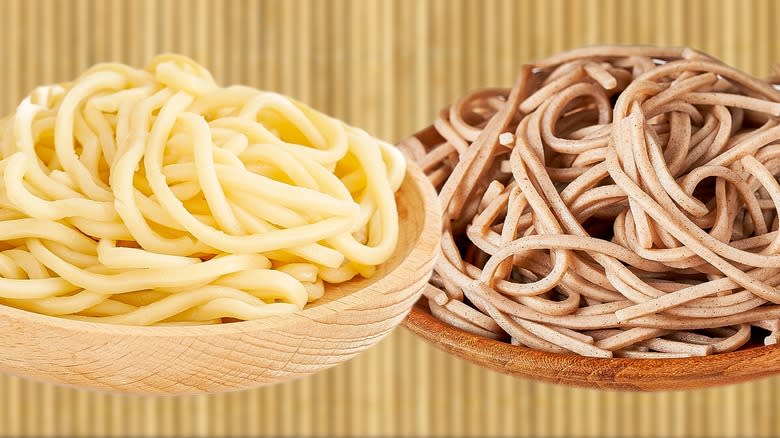
Noodles -- just the name itself inspires a good mood. Whether consumed on-the-go in instant form or cooked to perfection in a fine-dining establishment, the food transcends contexts. Enjoyed in most Asian cultures, this starch-based creation is a central part of Japanese cuisine. In addition to all the beloved types of ramen, the nation's two other noted varieties are udon and soba.
You might have noticed them sold side by side in the noodle aisle of your grocery store, but the two foods actually entail many contrasting qualities. For one, udon is made with flour, while soba is buckwheat-based, which lends it a different texture, taste, and color. The two noodles are further cut to different sizes and used in both overlapping and distinct dishes, making them a fascinating culinary contrast.
In fact, even the serving contexts of the two noodle types varies. Udon is a tasty fast-food meal -- much like ramen -- enjoyed at casual counters with a fast turnover rate. On the contrary, soba often takes on a more upscale bent due to its labor-intensive creation process. You'll find it handcrafted and enjoyed in elegant settings. Such a range of differences means there's quite a bit to unpack -- in terms of both flavor and customs -- between the two noodle types.
Read more: 26 Types Of Pasta Sauce Explained
What Is Udon?
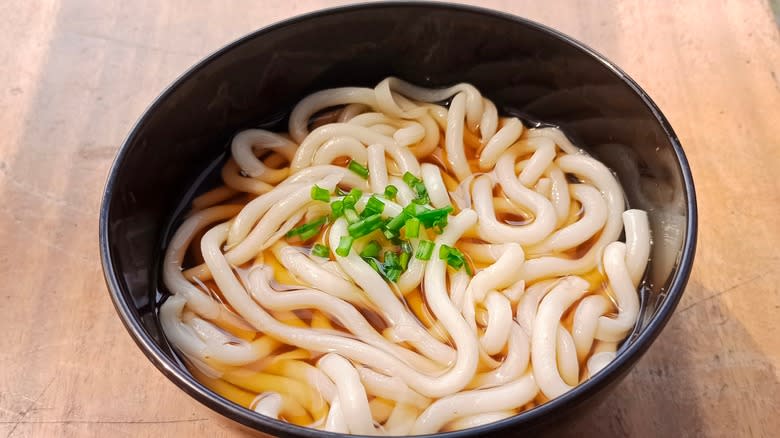
Udon is one of the most recognizable Japanese noodles, with a bright white color and a thick and chewy consistency. Most believe the dish came by way of China well over a millennium prior, but it didn't become a widespread food until the 17th century. Nowadays, udon is common across the country, but is especially popular in southern prefectures where wheat agriculture takes place.
Udon dough consists of only wheat flour, salt, and water, and famously requires intense kneading in order to combine. In domestic settings, many meld the dough by stomping with their feet (using protective layering). However, shops possess specialized high-pressure equipment. The dough is then subsequently rolled out, folded into an accordion shape, and sliced with a knife. Most udon noodles are cut into a small square-shaped cross-section with a long length. There are also flat-shaped, as well as very thin varieties.
Traditional udon is served in a dashi broth, the noodles aligning well with the savory-salty soup. Yet it can also be repurposed for other applications, too -- like yaki udon, curry udon, and many more. The thick nature of the noodles makes them a tasty standalone component, although they're also paired with seafood, meats, vegetables, and more.
What Is Soba?
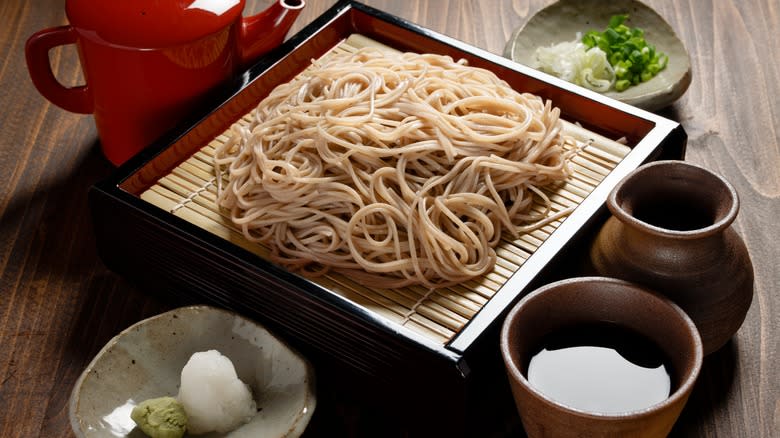
Soba noodles are one of Japan's most treasured culinary creations. In their simplest form, they require only two components -- buckwheat flour and water -- which results in a complex earthy and nutty taste. One thing to know about buckwheat is that it's a pseudo-cereal, so pure soba is gluten-free. Due to the delicate nature of the employed grain, binding the noodles is complicated. For durability, most noodle-makers turn to a composition with 20% wheat flour called nihachi. Although it is also possible to find juwari or pure soba.
You'll find soba noodles in the full array of packaged forms -- dried, frozen, or pre-cooked. Yet, the highest quality exemplars are made fresh by experienced chefs, who go through at least three years of training to learn the craft. In a twenty-minute-long process, the buckwheat flour is combined with water in precise ratios, rolled out and folded, and then sliced into noodles using a specialized knife. To best enjoy this delicate texture, the noodles are quickly boiled, then cooled and eaten chilled with a dipping sauce. Sometimes even the cooking liquid is retained to fill up the dipping sauce with a soba-rich flavor.
Despite such a complex serving tradition, soba noodles are malleable and enjoyed in many other contexts, too. Tokyo's eki soba noodles are a train station delicacy, with a simple broth and topping combination. And you'll also find packaged noodles in soba stir fries or delicious soba noodle veggie bowls.
Udon Pairs Well With Heavier Stews And Rich Sauces
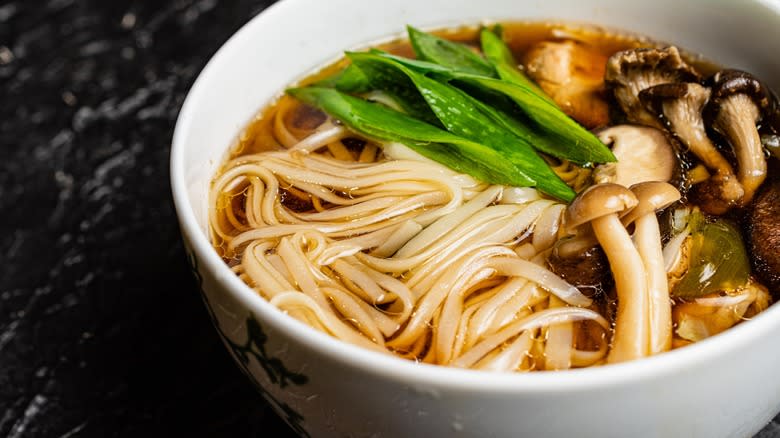
With their neutral flavor, udon noodles are a delicious vessel for a flavorful sauce or broth. They're not limited to a single format -- dishes like beef and udon stir fry showcase them in pan-tossed contexts. However, most eateries typically serve either in a hot broth or chilled with a dipping sauce.
Just like soba, udon can be served in a straightforward manner. The most common broth is called kakejiru, which consists of dashi, mirin, and soy sauce. This savory soup is a great way to enjoy the thick texture of noodles on their own or garnished with different toppings like tempura, fish cakes, or tofu. Meanwhile, the chilled udon is served with tsuyu, a dipping sauce, which repurposes the same broth components in an intensified form. In fact, it's the same condiment as soba dipping sauce.
While such dashi-based accompaniments undoubtedly lend udon a nice pop, udon's heftier texture also makes it a great vessel in stews, a dish soba would fall apart in. There are many variations of nabeyaki udon, which consists of rich broths starring fermented components like miso or kimchi. The noodles are cooked in the broth alongside a medley of vegetables, meats, and seafood. You'll also see the noodle paired with heavier proteins like beef in niku udon -- a rarity for soba. And, of course, there's beloved curry udon, which can even add milk for a rich and creamy textures. Such a range of ingredients showcases udon's easily-to-cook potential, as opposed to soba's delicate nature.
Soba's Delicate Nature Shines With Simple Accompaniments
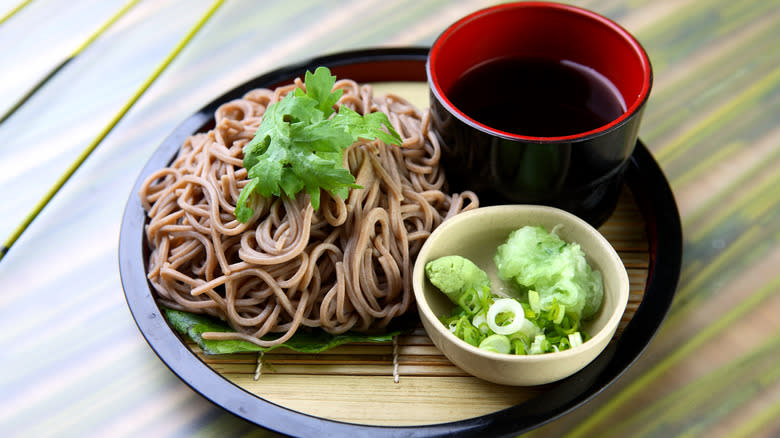
Like udon, most soba is also served either in a broth or chilled. However, its regional assortment of dishes typically takes on a simpler composition. With the noodle's more aromatic intrinsic flavor, as well as fragile texture, broths and sauces let the soba shine. The most popular soup base is the same as for udon, called kake soba to match the noodle name. It consists of the same dashi-based broth, often served with a poached egg in this rendition. Analogously, cold soba is dipped into the same combination of ingredients, in a popular dish called zaru soba. The cold temperature is a great way to enjoy the noodle, with most soba dishes available hot or cold.
Regional soba variations typically keep the dashi broth or sauce and inflect flavors through toppings. There's kitsune soba, which throws in some deep-fried tofu, or tanuki soba, which comes with tempura bits. And some alter the noodle recipe, like in the city of Uji, where a matcha soba dough crafts a green tea rendition.
With soba's availability in packaged format the noodle can also be repurposed into less traditional dishes, too. Enjoy a silken tofu soba salad or a pungent garlic and chili soba dish to taste the food in reinvented form. Just know that stir-fries and salads aren't traditionally Japanese uses of soba. And if you do order yaki soba, it likely won't contain buckwheat noodles, since the word soba can refer to other noodle varieties.
Soba Noodles Are The Star Of Upscale Eateries
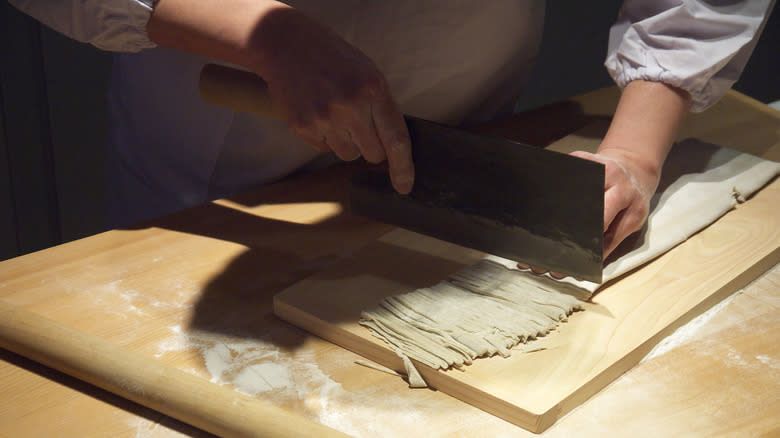
For most of its history in Japan soba was far from a formal food and instead more associated with farmers. Nevertheless, the noodles always carried a special meaning, especially due to their creation in the context of Buddhist monasteries. Temples would open shops that catered specifically soba-centric foods for monks and even supplied royal palaces. Such a tradition carried over into upscale establishments, which took off in the 18th century.
Combined with the fact that soba is frequently complemented with sake -- since Japan's sipping rice wine isn't consumed with rice foods -- soba making emerged as its own esteemed culinary niche. Today, soba masters continue to draw intrigue both in Japan and abroad, showcasing their deft understanding of soba's flavor and delicate texture.
Upscale soba shops often have a tranquil environment, reminiscent of a sushi bar. They'll combine exquisitely made soba with perfectly formed side dishes, like tempura, seafood, or duck. Elevated with the nice alcohol selection, it makes for a particularly captivating -- and relaxing -- way of enjoying the noodle dish, a context you won't find for udon. Such a fine-dining predisposition showcases the complexity of Japanese noodle-making, with only a few ingredients elevated to a dazzling form.
Read the original article on Tasting Table

 Yahoo Lifestyle
Yahoo Lifestyle 
